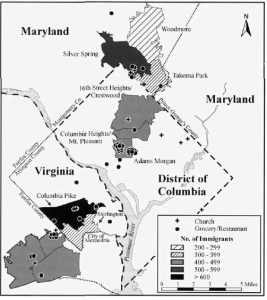Many Americans believe that immigrants, especially those whom do not speak English and are not white, create miniature versions of home in American cities. It is true that, in Washington, D.C., Ethiopian businesses and homes have existed since the late 1970s. In her article “Ethiopian Ethos,” Elizabeth Chacko calls these neighborhoods ethnic sociocommerscapes where “Ethiopians sustain their ethnic identity and heritage in ways that leave imprints on the urban and suburban landscapes.”[i] However, as seen through maps from the 1980’s to the present, the boundaries of these “Little Ethiopias” evolve over time. While many commercial locations remain inside the city, Ethiopian immigrants today are more likely to live in Alexandria, Virginia and or Silver Spring, Maryland. These neighborhoods and commercial areas are separated from one another, and additionally far less homogenous than perceived.
Figure 1
Courtesy of Emily Wax, “Ethiopian Yellow Pages: Life, By the Book,” The Washington Post, June 8, 2011, accessed October 26, 2016, https://www.washingtonpost.com/lifestyle/style/ethiopian-yellow-pages-life-by-the-book/2011/06/01/AGM64YMH_story.html.
According to the information available in Mama Tutu’s Ethiopian Yellow Pages (Figure 1), a directory for Ethiopian businesses throughout the area, it appears that the first recorded concentration of one of these ethnic sociocommerscapes was in DC’s Adams Morgan neighborhood in the late 1980’s.[ii] In the 1990’s, another concentration of Ethiopian businesses and homes appeared on U Street, not too far from Adams Morgan.[iii] Today, many of the newer businesses listed in Mama Tutu’s Yellow Pages are things like camps, churches, and soccer teams in Arlington and Silver Spring.[iv] This is important because it means businesses by and for Ethiopian immigrants in the surrounding suburbs of D.C. are advertising elsewhere.
This trend of Ethiopian ethnic sociocommerscapes stretching beyond the D.C area in multiple locations can also be seen in Chacko’s article. She includes a map of where Ethiopian immigrants live and have businesses in Washington D.C. that she created using census data from 2009. As seen in her map (Figure 2), there are still businesses, like grocery stores and restaurants, in Adams Morgan , but more Ethiopians are actually living in Silver Spring, Maryland or Arlington, Virginia.
Figure 2
Courtesy of Elizabeth Chacko, “Ethiopian Ethos and the Making of Ethnic Places in the Washington Metropolitan Area,” Journal of Cultural Geography 20 no.2 (2009)
In an article from 2015 in the Greater Greater Washington, a Washington D.C. online news source, journalist Dan Reed also explains the evolution of Ethiopian neighborhoods. In a map created by Reed (Figure 3), it is evident that most Ethiopian immigrants have moved entirely out of the district. Although they have many businesses inside the city, most of them by 2015 live either in Silver Spring or Fairfax.[v] Reed explains that this is likely due to the high costs of living inside the city (and possibly the inner suburbs), crime rates, and the quality of schools in the surrounding areas.[vi]
Figure 3
Courtesy of Dan Reed, “Little Ethiopia has Moved to Silver Spring and Alexandria,” Greater Greater Washington, September 14, 2015, accessed October 27, 2016, http://greatergreaterwashington.org/post/27954/dcs-little-ethiopia-has-moved-to-silver-spring-and-alexandria/.
What these maps show is that “Little Ethiopia” is not isolated to one area nor is it excluded to Ethiopian immigrants. Currently, Ethiopians in America live in different areas than they work and develop new businesses all throughout the Washington area. Although they have commercial areas inside the city, they live in the surrounding suburbs. While they undoubtedly create communities, or ethnic sociocommerscapes, they are far more integrated into the city than a term like “Little Ethiopia” would let us believe.
[i] Elizabeth Chacko, “Ethiopian Ethos and the Making of Ethnic Places in the Washington Metropolitan Area,” Journal of Cultural Geography 20 no.2 (2009): 29.
[ii] Emily Wax, “Ethiopian Yellow Pages: Life, By the Book,” The Washington Post, June 8, 2011, accessed October 26, 2016, https://www.washingtonpost.com/lifestyle/style/ethiopian-yellow-pages-life-by-the-book/2011/06/01/AGM64YMH_story.html.
[iii] Ibid.
[iv] Ibid.
[v] Dan Reed, “Little Ethiopia has Moved to Silver Spring and Alexandria,” Greater Greater Washington, September 14, 2015, accessed October 27, 2016, http://greatergreaterwashington.org/post/27954/dcs-little-ethiopia-has-moved-to-silver-spring-and-alexandria/.
[vi] Ibid.



